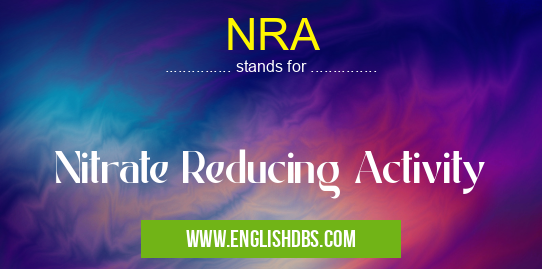What does NRA mean in UNCLASSIFIED
Nitrate Reducing Activity (NRA) is a crucial ecological process in environments, including aquatic and terrestrial ecosystems. It involves the conversion of nitrates (NO3-) and nitrites (NO2-) into gaseous forms of nitrogen such as dinitrogen gas (N2) or nitrous oxide (N2O) through the process of denitrification.

NRA meaning in Unclassified in Miscellaneous
NRA mostly used in an acronym Unclassified in Category Miscellaneous that means Nitrate Reducing Activity
Shorthand: NRA,
Full Form: Nitrate Reducing Activity
For more information of "Nitrate Reducing Activity", see the section below.
Processes involved in NRA
- Nitrification: This is the initial step where ammonia or ammonium is converted to nitrites and nitrates.
- Denitrification: This is the core process of NRA where nitrates and nitrites are reduced and converted into nitrogen gas and/or nitrous oxide.
- Dissimilatory Nitrate Reduction to Ammonia (DNRA): In some cases, nitrates are directly converted into ammonia rather than nitrogen gas.
Importance of NRA
- Nutrient Cycling: NRA aids in the recycling of nitrogen, an essential nutrient for plant growth, back into the atmosphere.
- Removal of Excess Nitrogen: High levels of nitrogen can cause eutrophication and other environmental issues. NRA helps remove these excess nitrates.
- Greenhouse Gas Mitigation: Denitrification can produce nitrous oxide, a potent greenhouse gas. However, it also reduces the emission of other greenhouse gases like methane.
Factors Affecting NRA
- Electron Donors: Organic matter, sulfide, or hydrogen can serve as electron donors for denitrifying bacteria.
- Oxygen Availability: Denitrification occurs in anaerobic conditions, where oxygen is limited.
- pH and Temperature: Optimal NRA occurs within a specific pH and temperature range.
Essential Questions and Answers on Nitrate Reducing Activity in "MISCELLANEOUS»UNFILED"
What is Nitrate Reducing Activity (NRA)?
Nitrate Reducing Activity is the biochemical process by which certain microorganisms convert nitrate (NO3-) into nitrogen gas (N2). This process plays a crucial role in the nitrogen cycle, removing excess nitrates from the environment.
What are the different types of NRA? A: There are two main types of NR
There are two main types of NRA:
- Dissimilatory Nitrate Reduction to Ammonium (DNRA): In this process, nitrate is converted into ammonium (NH4+), which can then be used by plants or further transformed into nitrogen gas.
- Assimilatory Nitrate Reduction (ANR): Nitrate is reduced to nitrite (NO2-) and then incorporated into organic molecules, such as amino acids and proteins.
What are the factors that affect NRA?
Several factors influence the rate and efficiency of NRA, including:
- Nitrate concentration
- Temperature
- pH
- Oxygen availability
- Presence of organic matter
What is the role of NRA in wastewater treatment?
NRA is an important process in wastewater treatment, as it helps remove excess nitrates from the water. High nitrate levels can have negative environmental impacts, such as contributing to eutrophication and groundwater contamination.
What are the potential benefits of enhancing NRA?
Enhancing NRA can provide several benefits, including:
- Reduced nitrate pollution in water bodies
- Improved water quality
- Increased nitrogen availability for plant growth
- Mitigation of climate change effects
Final Words: NRA is a vital ecological process that contributes to nutrient cycling, regulates nitrogen levels, and influences greenhouse gas emissions. Understanding the factors that influence NRA is crucial for managing ecosystems and mitigating environmental impacts.
